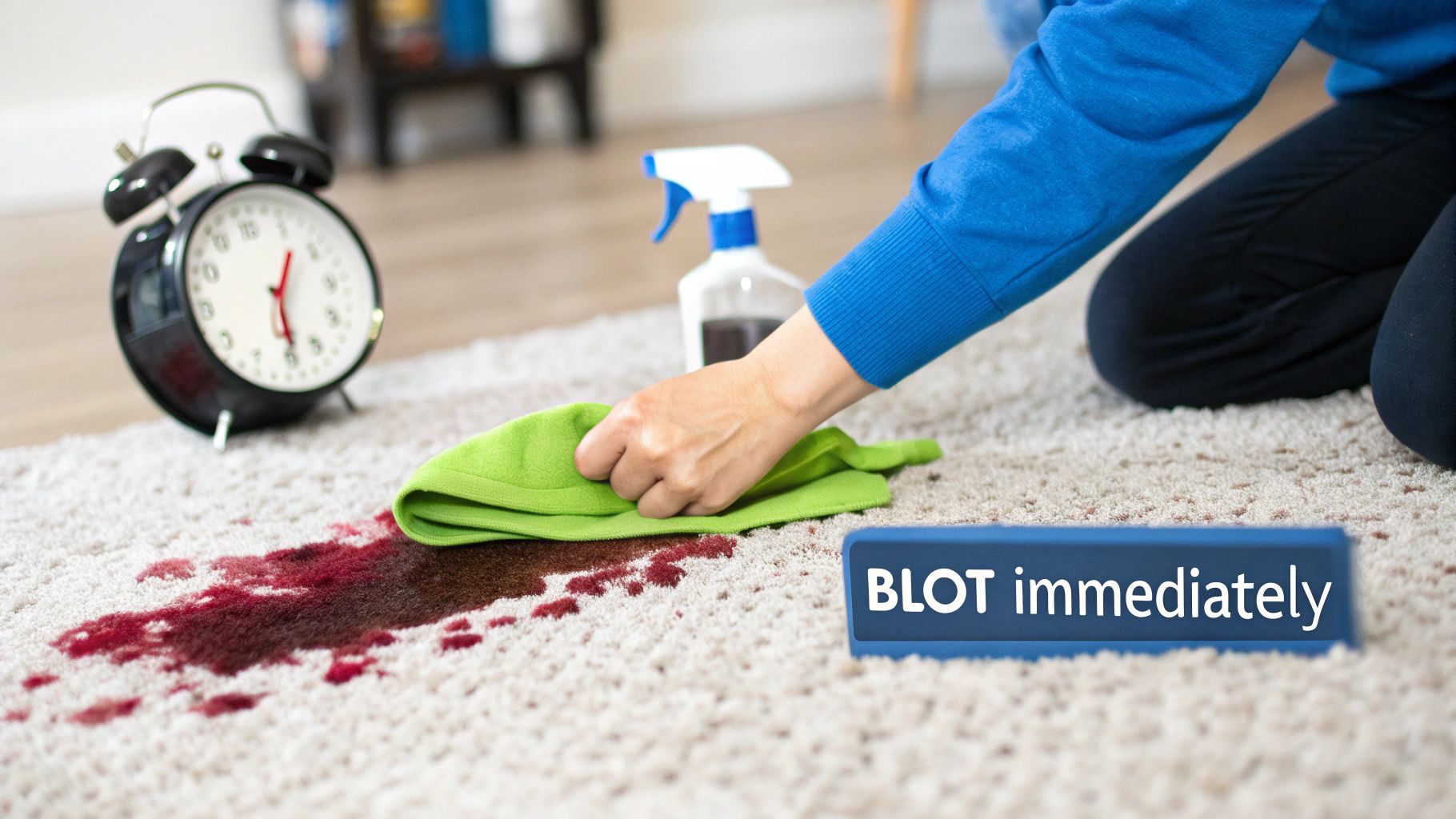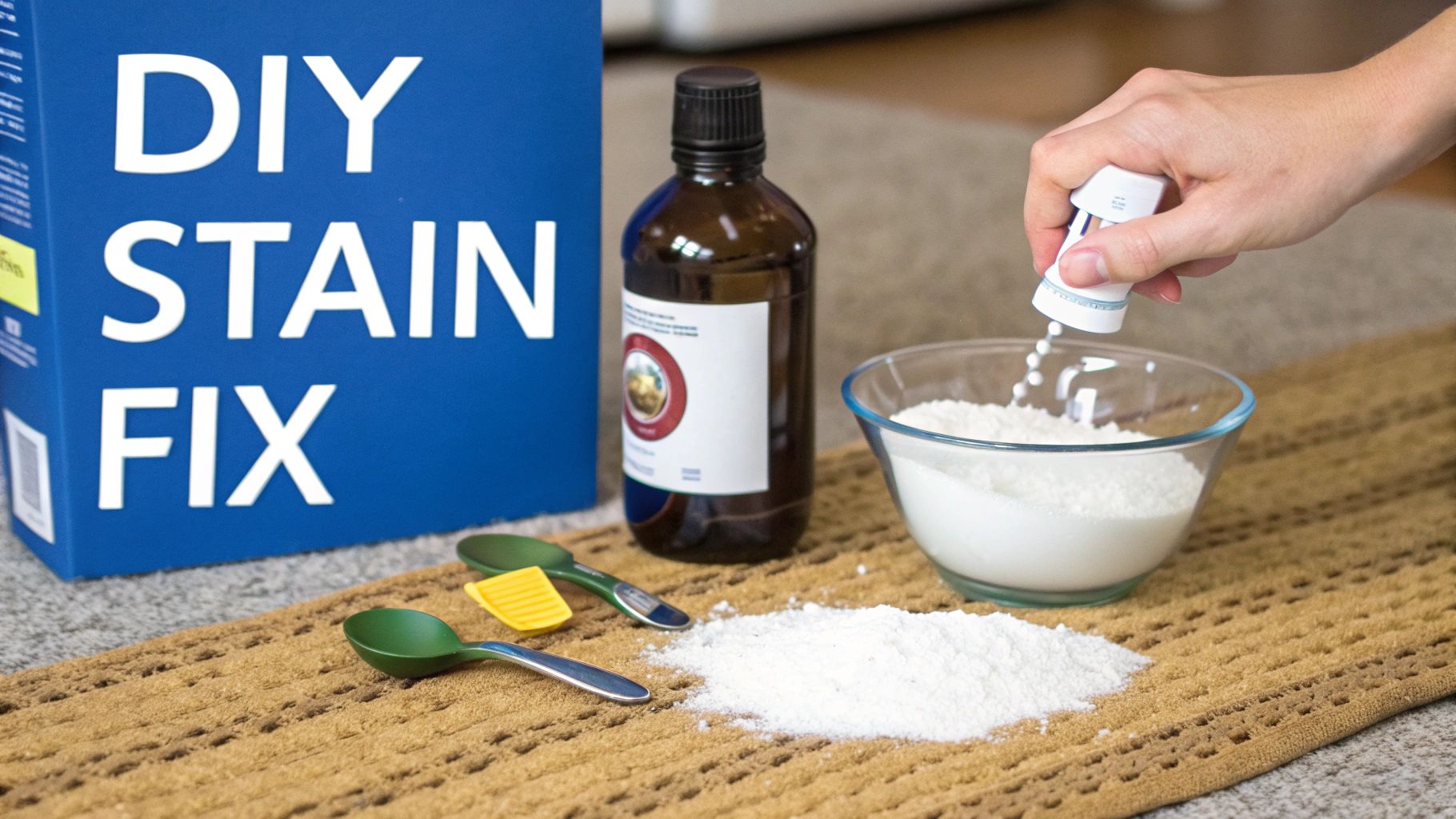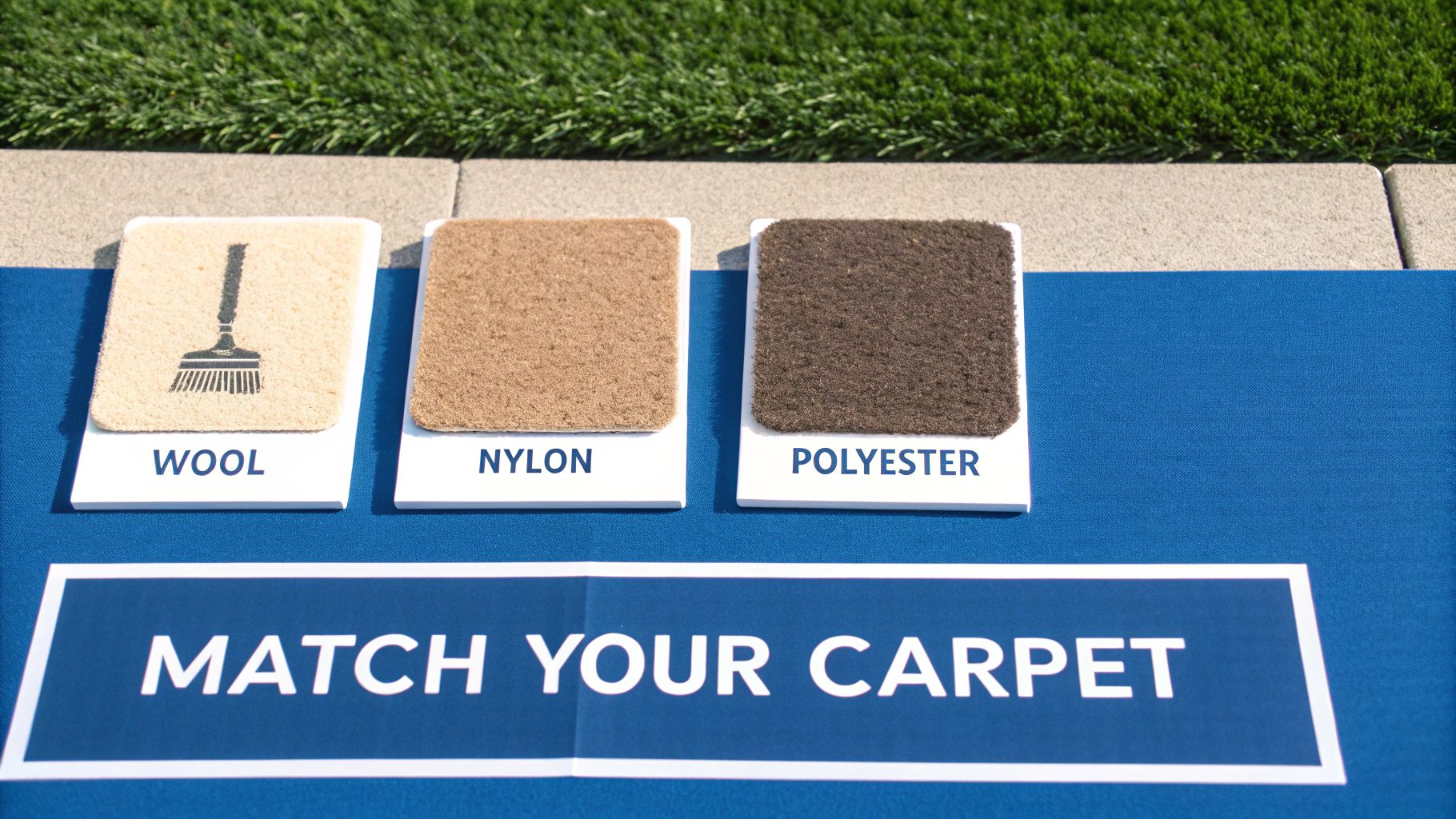That heart-stopping moment a glass of red wine tumbles onto your pristine carpet doesn’t have to end in a permanent stain. We’ve all been there. The key isn’t some magic formula; it’s acting fast with the right technique. It all comes down to blotting—not scrubbing—and using a few simple household items to tackle the spill before it properly sets in.
The First 10 Minutes After a Red Wine Spill
The second that cabernet hits your carpet, a chemical race against the clock begins. Red wine is loaded with chromogens (the compounds that give it that rich colour) and tannins (plant-based molecules that are fantastic for flavour, but also help pigments latch onto fibres). When these hit your carpet, they immediately start searching for something to bond with—and the porous fibres of wool, nylon, or polyester are the perfect target.
Your main goal in these first few critical moments is interruption. You need to stop that wine from soaking deeper into the carpet and its backing, and prevent those tannins from forming a permanent chemical bond. This isn’t about deep cleaning just yet; it’s pure damage control.
Stop Scrubbing and Start Blotting
The single most common—and most damaging—mistake people make is to panic and scrub the stain like mad. This action only grinds the wine pigments deeper into the carpet pile. Worse, it can fray the fibres, leaving the area looking fuzzy and worn even if you manage to lift the colour.
Instead, your mantra should be: blot, blot, and blot again.
Grab a clean, dry, white cloth or a stack of paper towels. Using a white cloth is non-negotiable, as coloured towels can actually transfer their dye onto the carpet, leaving you with a second, more complicated stain. Press the cloth firmly onto the spill, letting it soak up as much liquid as it can. Lift it, find a clean, dry section, and press down again. Keep repeating this until your cloth is barely picking up any moisture. You’re lifting the stain out, not pushing it around.
This simple infographic breaks down those essential first actions.

As the visual guide shows, your immediate response should be all about lifting the spill by blotting, diluting what’s left, and then blotting again to soak up the excess moisture.
Sometimes, seeing the steps laid out in a timeframe helps you react without having to think too hard. Here’s a quick-reference plan for the moment a spill happens.
Your Emergency Red Wine Stain Response Plan
| Timeframe | Action | Why It’s Critical |
|---|---|---|
| 0–2 Mins | Grab clean, white cloths/paper towels and blot firmly. Do not rub. | This immediately lifts the majority of the liquid wine before it can soak into the carpet backing. |
| 2–5 Mins | Continue blotting with fresh cloths until almost no more wine is transferring. | Removing excess liquid is the most important step. It makes any follow-up cleaning far more effective. |
| 5–10 Mins | Lightly dampen the area with cool water or club soda. Blot again. | This dilutes the remaining wine, breaking it down and making it easier to lift out of the fibres. |
This initial response plan is often the most critical part of the entire process, setting you up for success with the deeper cleaning steps that follow.
Why Every Second Counts
When we say act fast, we really mean it. It’s not just a friendly suggestion—it’s the single most important factor in stopping a permanent mark from forming. Research conducted right here in Australia highlights this urgency, revealing that up to 70% of red wine stains can become permanent if not treated within the first 10 minutes. That statistic is alarming, but it shows just how quickly the wine’s tannins create a lasting bond with carpet fibres. Wait too long, and removal becomes exponentially harder. You can discover more about stain permanence and why immediate action is so critical by reading the full findings.
Key Takeaway: The first 10 minutes are your golden window. What you do (or don’t do) in this timeframe will largely determine whether you’re dealing with a minor clean-up or a permanent carpet blemish.
After you’ve blotted away most of the spill, you can apply a small amount of cool water or club soda directly to what’s left of the stain. The liquid helps dilute the remaining wine, making it easier to blot away. Just be careful not to completely saturate the area, as this can push the stain down into the carpet pad. A light pour is all you need, then get back to your gentle blotting process until the stain has faded significantly.
Your Guide to DIY Red Wine Stain Removal

So, you’ve managed the initial spill with some quick blotting—well done. Now it’s time to deal with what’s left behind. The good news is you probably have everything you need to tackle the rest of the stain hiding in your kitchen pantry. Many common household items are surprisingly powerful cleaning agents, working on a chemical level to break down and lift those stubborn red wine pigments.
But before you reach for any solution, homemade or store-bought, there’s one step you absolutely cannot skip: the patch test. Find a hidden spot on your carpet, maybe inside a wardrobe or behind a lounge, and apply a tiny amount of your cleaning mix. Let it sit for a few minutes, then blot it dry. This quick check ensures you won’t accidentally discolour or damage the carpet fibres, saving you from turning a small stain into a much bigger headache.
The Salt Method for Fresh Stains
If the stain is still damp, salt is your best friend. It’s a fantastic first-response tool that works through osmosis, literally pulling the wine out of the carpet fibres and into the salt crystals. Think of it as a magnet for moisture.
- Be generous with the salt: Don’t just sprinkle a little on top. You need to cover the entire stain with a thick, generous layer.
- Let it do its thing: Now, you wait. You’ll see the salt start to turn pink as it absorbs the wine. This can take a few hours or even overnight, depending on the size of the spill.
- Vacuum it all up: Once the salt looks dry and has absorbed as much wine as possible, just vacuum it away. The stain should be dramatically lighter.
While the salt method is brilliant for minimising damage right away, it often leaves a faint mark behind. It’s an excellent starting point, but you’ll probably need to follow up with a liquid cleaner to finish the job.
The White Vinegar and Bicarb Soda Solution
For stains that need a bit more muscle, the classic combination of white vinegar and bicarbonate of soda creates a fizzing reaction that lifts stains right out of the carpet pile. There’s a reason this duo is a go-to for so many household cleaning tasks. The vinegar (an acid) works to break down the wine’s pigments, while the bicarb soda (a base) reacts to lift the particles up and away.
First, mix a solution of two parts water to one part white vinegar. Using a clean, white cloth, gently dab this mixture onto the stain. Avoid pouring it directly onto the carpet, as you want to control how much liquid you’re adding.
Once you’ve applied the vinegar solution, sprinkle a light layer of bicarb soda over the damp area. You’ll hear a satisfying fizzing sound—that’s the reaction getting to work. Let it sit until the fizzing stops and it forms a paste, then allow it to dry completely before vacuuming up the residue.
Harnessing the Power of Hydrogen Peroxide
For light-coloured or white carpets, hydrogen peroxide can be a real game-changer. But it’s important to know what you’re working with. Research shows that red wine stains are so tough because of their mix of tannins and biochemical dyes. To fight this, experts often turn to bleaching agents, and oxidising agents like hydrogen peroxide are a popular choice in Australian homes because they’re effective and relatively safe when used correctly. You can read the full research on stain composition and treatment to learn more about the science.
Crucial Warning: Hydrogen peroxide is a mild bleaching agent. NEVER use it on dark or brightly coloured carpets without doing a very thorough patch test first. It can permanently strip the colour from the fibres.
If your carpet is a suitable colour, mix one part 3% hydrogen peroxide with two parts water. Some people find that adding a single drop of clear dish soap helps break the surface tension. Lightly apply the solution, let it sit for no more than 30 minutes, and then gently blot with a clean cloth. To finish, rinse the spot by dabbing with a water-dampened cloth and then blot it dry. This is often the final DIY step people try before calling in the professionals.
These homemade solutions are a practical and budget-friendly way to handle a red wine emergency. By understanding how each ingredient works, you can pick the right method for your carpet and tackle stains with a bit more confidence.
Matching Cleaning Methods to Your Carpet Type

Treating every carpet the same is one of the fastest ways to turn a small spill into a permanent disaster. A cleaning solution that works wonders on a tough synthetic rug could completely ruin natural wool fibres. The material your carpet is made from dictates everything—how it absorbs the wine, and how it will react to whatever you use to clean it.
Knowing what you’re working with is the first step. This isn’t just about lifting the stain; it’s about protecting the colour, feel, and overall life of your carpet. The wrong product can cause fading, fraying, or even weaken the carpet’s structure.
Working with Synthetic Carpets Like Nylon and Polyester
Most modern Aussie homes have synthetic carpets, usually nylon, polyester, or polypropylene. There’s a good reason for their popularity: they’re built to be durable, resilient, and often come with some level of stain resistance straight from the factory. This makes them a bit more forgiving when you’re trying to figure out how to remove red wine stains from carpet.
Because synthetic fibres are less absorbent, the wine often beads on the surface for a little longer, giving you more time to act. You can generally get away with using more robust DIY solutions on these.
- Vinegar and Bicarb Soda: This classic combo is usually safe and quite effective on synthetic carpets.
- Hydrogen Peroxide Mix: For light-coloured synthetic carpets, a carefully patch-tested solution of hydrogen peroxide and water can be your secret weapon against a really stubborn stain.
But even with their durability, you should always do a patch test first. Some cheaper synthetics can have less stable dyes, so it’s always better to be safe than sorry.
The Special Case of Wool Carpets
Wool is a gorgeous, luxurious natural fibre, but it needs a much gentler touch. It’s incredibly absorbent, which means it soaks up spills like red wine almost instantly, letting the pigments dive deep into the core of the fibre. Trying to scrub it out aggressively is not the answer here.
Harsh chemicals, particularly alkaline ones (with a high pH), will strip the natural lanolin oils from the wool, leaving it feeling brittle and looking dull. High heat is another enemy—it can cause the fibres to shrink or felt.
Think of wool fibres like human hair. You wouldn’t wash your hair with a harsh kitchen cleaner, and the same logic applies to your wool carpet. Always stick to gentle, pH-neutral solutions.
For wool, stay far away from ammonia-based cleaners, strong detergents, and be extremely careful with hydrogen peroxide. Often, the safest bet is a simple mix of cool water with a single drop of clear, pH-neutral dish soap. Apply it sparingly and blot, don’t rub.
Over the years, we’ve seen firsthand how much the success rate of wine stain removal depends on the fibre. Wool carpets are a real challenge because their fibres just don’t want to let go of red wine stains like synthetics do. You can learn more about how professionals handle different fibre types on rugclean.com.au.
A Quick Guide to Carpet Fibres
Not sure what kind of carpet you have? This table breaks down the basics to help you choose the right game plan.
Stain Removal Methods by Carpet Fiber Type
| Carpet Fiber | Recommended DIY Solution | Important Precautions |
|---|---|---|
| Nylon/Polyester | Vinegar & bicarb soda or a diluted hydrogen peroxide solution. | Durable, but always patch test to check for colourfastness, especially with peroxide. |
| Wool | A few drops of pH-neutral dish soap mixed with cool water. | Avoid hot water, ammonia, and high-pH cleaners. Blot gently to prevent felting. |
| Polypropylene (Olefin) | Water-based solutions like vinegar or mild soap. | Highly stain-resistant but can be damaged by oil-based substances and certain solvents. |
At the end of the day, figuring out your carpet’s material is just as critical as your cleaning technique. A moment spent checking if you have a sturdy synthetic or a delicate natural fibre will guide your whole approach and save you from a very costly mistake. If you’re ever in doubt, your safest bet is to use the mildest cleaning agent you can—or just give the experts a call.
Common Mistakes That Set Wine Stains Permanently

In the chaos of a spill, it’s human nature to want to fix things immediately. But when it comes to red wine on your carpet, some of the most intuitive reactions are the very things that can turn a treatable spot into a permanent blemish.
Knowing what not to do is just as crucial as knowing the right steps. The wrong move can chemically set the stain, damage the carpet fibres, or even introduce a brand-new problem. By avoiding these common pitfalls, you give yourself the best possible chance of a complete, traceless cleanup.
The Number One Mistake: Scrubbing the Stain
Your first instinct might be to grab a cloth and scrub the spill with all your might. This is the single worst thing you can do.
Scrubbing doesn’t lift the wine; it aggressively grinds the pigments deeper into the carpet fibres. This not only makes the stain larger but pushes it so far down that it becomes nearly impossible to remove. On top of that, the forceful action can untwist and fray the carpet pile, leaving a permanently fuzzy, damaged patch even if you manage to get the colour out.
Always remember to blot gently, working from the outside of the stain inwards to stop it from spreading.
Applying Heat in Any Form
Heat is a catalyst for chemical reactions, and when it comes to red wine, it acts like superglue for stains. Using hot water, a hairdryer, or a steam cleaner on a fresh wine spill will effectively “cook” the wine’s sugars and tannins into the carpet fibres.
This process, known as setting the stain, creates a permanent chemical bond that even professional cleaners can struggle to break.
Expert Tip: Always use cool or lukewarm water when treating a red wine stain. Heat is the enemy and will almost guarantee the stain becomes a permanent feature on your floor.
Cool water helps dilute the wine without speeding up that bonding process, making it much easier to blot away.
Using the Wrong Cleaning Agents
Not all cleaners are created equal, and what works wonders on a kitchen bench can be a total disaster for a carpet. Certain chemicals can cause irreversible damage, from bleaching the colour right out to dissolving the fibres themselves.
Here are a few culprits to avoid at all costs:
- Chlorine Bleach: It might seem like the ultimate stain remover, but bleach will permanently strip the colour from most carpets. You’ll be left with a prominent white or yellowish patch that’s far more noticeable than the original stain ever was.
- Ammonia: This is a highly alkaline substance that can damage natural fibres like wool and often causes discolouration on synthetic carpets, too.
- Coloured Cloths or Towels: When you apply a cleaning solution and start blotting, any dye in your cleaning cloth can easily transfer to the carpet. This creates a secondary stain, complicating the entire cleanup process. Always stick to plain white cloths, paper towels, or colour-fast microfibre towels.
By steering clear of these common blunders, you’re not just cleaning a spill—you’re preserving the look and feel of your carpet. Patience and the right technique are far more effective than panicked scrubbing or harsh chemicals. It’s about working smart, not hard, to ensure that wine stain is a temporary accident, not a permanent regret.
When to Call a Professional Carpet Cleaner
While DIY methods can work wonders on fresh, minor spills, there are times when your best efforts just won’t cut it. Knowing when to step back and call in the experts is crucial for protecting your carpet from permanent damage. Believe me, sometimes a home remedy can actually make things worse by pushing a stain deeper or setting it permanently.
Recognising the limits of your household toolkit is key. Certain situations demand the advanced equipment and specialised knowledge that only a professional service like Right Price Carpet Cleaning can provide. Trying to tackle a major spill or a delicate fibre with the wrong approach can be a very expensive mistake.
Signs It’s Time for a Professional
Sometimes the stain itself will tell you it’s out of your league. If you’re facing one of the following scenarios, putting down the bicarb soda and picking up the phone is your smartest move. These are clear indicators that a professional touch is needed to get the job done right.
- The Stain Is Old and Set-In: Found a red wine stain from last week’s party? It has had plenty of time to bond with the carpet fibres. A dried, set-in stain is significantly harder to remove than a fresh one because the pigments are deeply embedded.
- The Spill Is Very Large: A knocked-over bottle of shiraz presents a much bigger challenge than a small splash. Large spills saturate not just the carpet pile but also the backing and even the underlay, creating a risk of mould and persistent odours if not extracted properly.
- Your Carpet Is Delicate or Expensive: If the spill is on a wool, silk, or antique rug, the stakes are much higher. These natural fibres are sensitive to the pH levels of cleaning solutions and can be easily damaged by DIY methods, leading to colour loss or fibre deterioration.
The Professional Advantage
So, what do professionals bring to the table that you can’t replicate with a pantry cleaner? It really comes down to industrial-strength technology and chemistry. Professional cleaners have access to powerful equipment and solutions designed for the toughest jobs.
A professional carpet cleaner doesn’t just treat the surface; they extract the stain from deep within the carpet’s foundation. This is the difference between making a stain look better and removing it completely.
At Right Price Carpet Cleaning, for example, we use powerful truck-mounted steam cleaning machines. These units generate much higher heat and suction than any rental or domestic machine could ever hope to achieve. This combination allows us to flush the stain with specialised, pH-balanced solutions and then extract virtually all the moisture, along with the wine residue, dirt, and allergens.
This process ensures there’s no sticky residue left behind to attract more dirt, and the powerful extraction leads to much faster drying times, preventing secondary issues like mildew.
When you’re dealing with a stubborn mark that won’t budge or a precious rug you can’t risk damaging, calling a professional isn’t giving up—it’s making an informed decision. For stubborn red wine stains that seem impossible, trusting a team with the right tools and experience is the best way to restore your carpet and protect your investment.
Frequently Asked Questions About Removing Wine Stains
Even with the best guide, panic can set in when you’re staring down a fresh red wine spill. It’s a high-stakes moment, and it’s natural to second-guess what you should be doing.
We get calls about this all the time, so we’ve pulled together the most common questions homeowners ask. Let’s clear up the confusion so you can act fast and get the best possible result.
Can I Use White Wine to Remove a Red Wine Stain?
This is one of those old tricks you hear about, but honestly, it’s more myth than magic. The theory is that the acids in white wine help break down the red wine pigments, making them easier to lift.
While it might dilute the stain a little, it’s a terrible idea in the long run. White wine leaves behind its own sugars, creating a sticky residue that will attract dirt over time. You’ll just end up with a new, grubby patch on your carpet.
Stick to plain cool water or club soda. They’ll dilute the stain just as effectively without leaving anything sticky behind.
Will Salt Actually Get a Red Wine Stain Out?
Salt is an absolute champion for first aid on a wet spill. It works through osmosis, literally pulling the red wine out of the carpet fibres and into the salt crystals. If you pour on a thick layer, you can actually watch the salt turn pink as it absorbs the liquid.
But salt is rarely the final step. It’s fantastic at damage control, pulling out a huge amount of the wine before it can set. However, it almost always leaves a faint stain behind, especially on lighter carpets.
Think of it as your best opening move in the fight, but you’ll need to follow it up with a proper cleaning solution to finish the job.
Key Insight: Salt is for absorption, not deep cleaning. Use it immediately to pull out as much liquid as possible, then move on to a cleaning solution to tackle what’s left.
Is It Possible to Remove an Old Dried Red Wine Stain?
Getting an old, set-in stain out is definitely tougher than dealing with a fresh one, but it’s not a lost cause. The main hurdle is that the wine’s pigments have had time to chemically bond with the carpet fibres.
Your first move is to rehydrate the stain. Gently dab the area with a cloth dampened with cool water to bring some moisture back into the fibres.
Once it’s damp, you can treat it with something more powerful, like a paste made from bicarb soda and water. You’ll likely need to repeat the process a few times—apply the solution, let it sit, blot it away, and assess. Patience is everything here. For really stubborn old stains, this is usually where DIY methods hit their limit and a professional touch is needed.
Do Commercial Wine Removers Work Better Than DIY Solutions?
Many of the top-quality commercial wine stain removers on the market are incredibly effective. They’re specifically formulated with enzymes and surfactants designed to target and dismantle the unique molecules in red wine, so they can work faster and more thoroughly than homemade options.
That being said, DIY solutions are perfect for that immediate, “what-do-I-do-right-now” moment when you don’t have a special product handy.
The best strategy is often a combination of both. Use a DIY method for the initial blotting and absorption, then keep a trusted, carpet-safe commercial remover in your cupboard for the follow-up treatment.
If you’ve tried everything and that stubborn red wine stain still won’t budge, don’t risk damaging your carpet by scrubbing it into oblivion. The professional team at Right Price Carpet Cleaning has the powerful truck-mounted equipment and specialised solutions to extract even the toughest, set-in stains. Protect your investment and restore your carpet’s beauty by booking a professional clean today.





Recent Comments